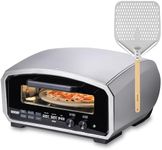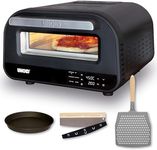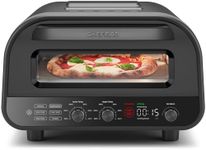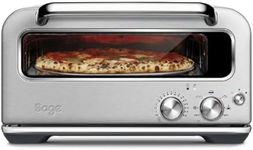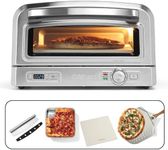Buying Guide for the Best Indoor Pizza Ovens
Choosing the right indoor pizza oven can greatly enhance your home cooking experience, allowing you to make delicious, restaurant-quality pizzas in the comfort of your own kitchen. When selecting an indoor pizza oven, it's important to consider various specifications that will affect the cooking process, the quality of the pizza, and how well the oven fits into your kitchen space and lifestyle. Understanding these key specifications will help you make an informed decision that aligns with your cooking needs and preferences.Size and CapacityThe size and capacity of an indoor pizza oven determine how much space it will take up in your kitchen and how large a pizza you can cook at one time. This is important because it affects both the convenience of using the oven and the quantity of food you can prepare. Smaller ovens are more compact and suitable for limited kitchen space or for cooking smaller pizzas, typically up to 12 inches. Medium-sized ovens can handle pizzas up to 14 inches and are a good balance for most households. Larger ovens can accommodate pizzas 16 inches or more, ideal for larger families or those who entertain frequently. Consider your kitchen space and how many people you typically cook for when choosing the size.
Heating MethodThe heating method of a pizza oven affects how quickly and evenly it cooks your pizza. Common heating methods include electric, gas, and wood-fired. Electric ovens are easy to use and maintain, offering consistent heat and are suitable for most home kitchens. Gas ovens heat up quickly and can provide a more authentic pizza flavor, but they require a gas connection. Wood-fired ovens offer the most traditional pizza flavor with a smoky taste, but they require more maintenance and space. Choose a heating method based on your cooking style, flavor preference, and kitchen setup.
Temperature RangeThe temperature range of a pizza oven determines how hot the oven can get, which affects the cooking time and the texture of the pizza crust. Higher temperature ranges, typically up to 900°F, allow for faster cooking and a crispier crust, similar to traditional pizzeria-style pizzas. Lower temperature ranges, around 500°F to 700°F, are suitable for more controlled cooking and softer crusts. Consider the type of pizza you enjoy and how quickly you want to cook it when evaluating the temperature range.
Cooking Surface MaterialThe material of the cooking surface in a pizza oven impacts heat retention and the quality of the pizza crust. Common materials include stone, ceramic, and metal. Stone and ceramic surfaces are excellent for retaining heat and creating a crispy crust, mimicking traditional brick ovens. Metal surfaces heat up quickly and are easier to clean but may not provide the same crust texture. Choose a cooking surface material based on your preference for crust texture and ease of maintenance.
Ease of Use and CleaningEase of use and cleaning are important considerations for the convenience of operating and maintaining your pizza oven. Features like digital controls, timers, and pre-set cooking modes can make the oven easier to use. Removable trays and non-stick surfaces can simplify cleaning. If you prefer a hassle-free cooking experience, look for ovens with user-friendly features and easy-to-clean designs. Consider how much time you want to spend on setup and cleanup when choosing an oven.



